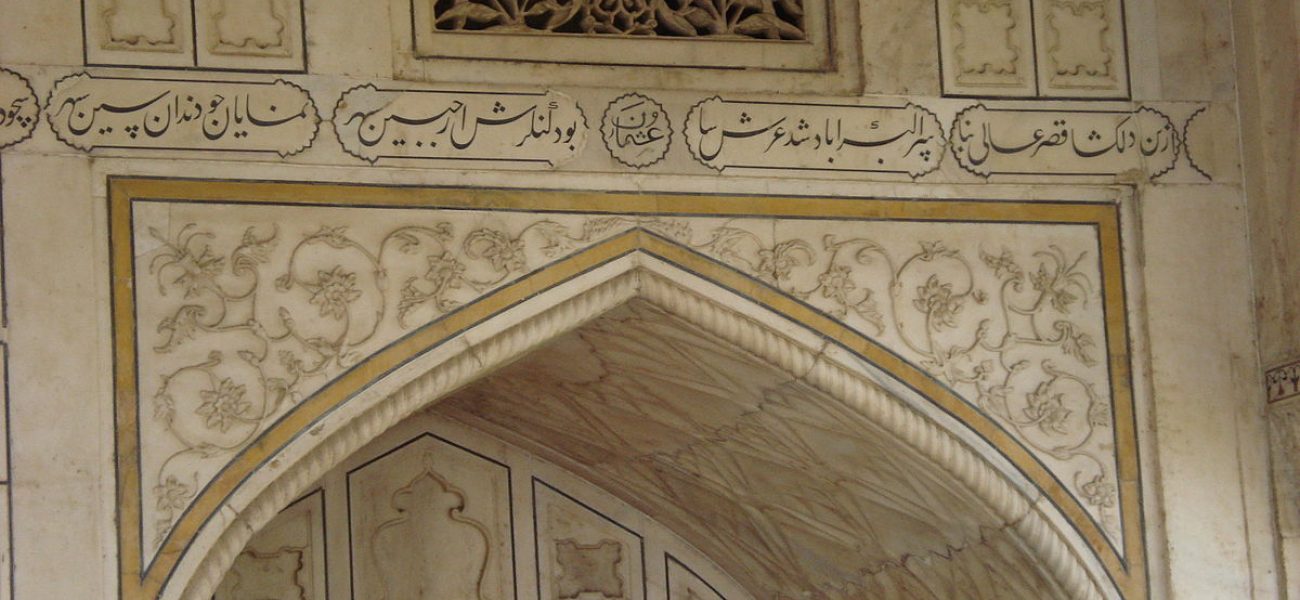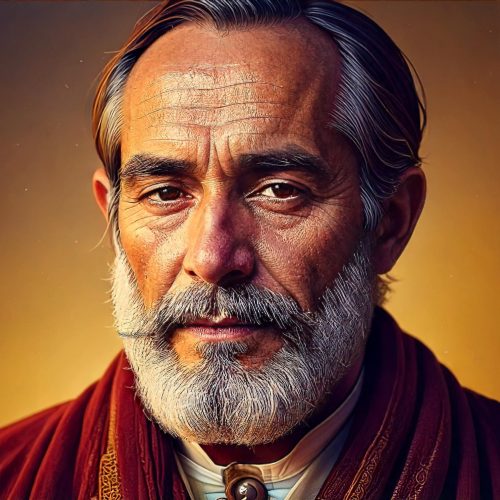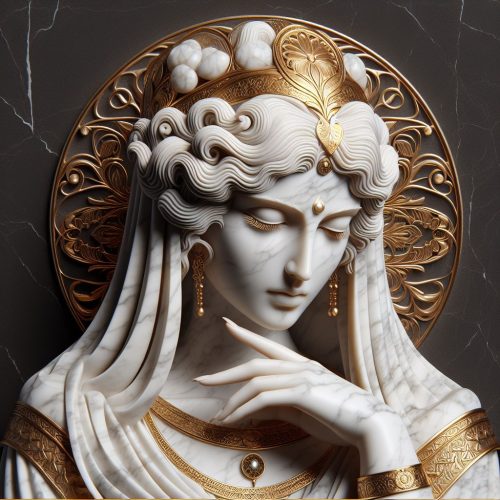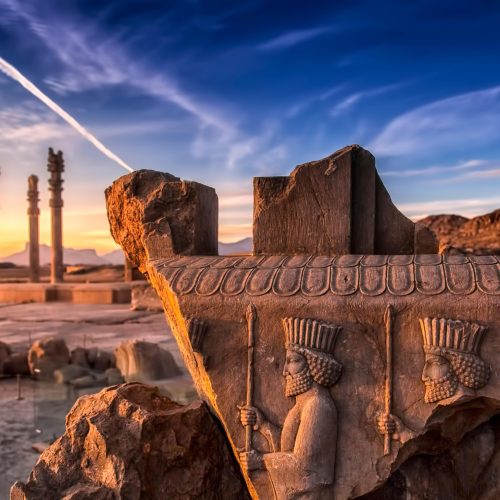In the heart of Persian culture lies an art form that transcends the mere boundaries of aesthetics and enters the realm of the spiritual: Persian calligraphy. This sacred art, woven into the fabric of Iranian identity, is more than a method of writing; it is a visual manifestation of the Persian soul. Each stroke, each curve, whispers secrets of centuries past, carrying the echoes of poets, philosophers, and mystics. As an Iranian calligrapher, my heart swells with reverence as I trace the lineage of this divine art, exploring its history, the evolution of Nasta’liq, the innovations of contemporary masters, and the modernist and post-modernist movements that continue to shape its path.
The History of Persian Calligraphy: Ink on the Canvas of Time
The history of Persian calligraphy is a journey through the evolution of the written word, a pilgrimage that begins in the ancient halls of Persia and winds its way through the centuries, adapting, flourishing, and branching into a myriad of styles. Persian calligraphy is not merely the act of writing; it is the articulation of thought, emotion, and spiritual introspection, expressed through the graceful lines and curves of the script.
The Birth of Calligraphy in Ancient Persia
The roots of Persian calligraphy can be traced back to the early Achaemenid Empire (550-330 BCE), where the cuneiform script was used to inscribe royal decrees and historical records. While cuneiform itself was not a form of calligraphy, it laid the groundwork for the significance of the written word in Persian culture. The real flowering of Persian calligraphy, however, began during the Islamic era when the Arabic script was adopted and adapted by the Persians.
With the advent of Islam in the 7th century, Persian calligraphy found a new canvas—parchment and paper—upon which it began to bloom. The Kufic script, characterized by its angular and geometric forms, was one of the earliest scripts used by Persian calligraphers. Kufic was primarily employed for religious texts, particularly the Qur’an, and its stark, almost architectural lines conveyed a sense of divine order and harmony.
As Persian culture absorbed and transformed Arabic script, the evolution of calligraphy accelerated. New scripts emerged, each reflecting the unique aesthetic sensibilities of Persian artisans. Among these, the Naskh script gained prominence for its legibility and elegance, becoming the standard for copying the Qur’an and other religious texts.
The Flourishing of Calligraphy in the Timurid and Safavid Eras
The true golden age of Persian calligraphy arrived with the Timurid and Safavid dynasties (14th-17th centuries). It was during these periods that Persian calligraphy reached unparalleled heights of sophistication and beauty, as calligraphers became revered as both artists and spiritual guides.
In the Timurid era, Herat became a renowned center for the arts, attracting poets, painters, and calligraphers. The script of choice during this period was Nasta’liq, often referred to as the “bride of calligraphy” for its delicate grace and flowing lines. The Nasta’liq script, with its elongated, sweeping curves and subtle elegance, captured the essence of Persian aesthetics. It was during this time that Mir Ali Tabrizi, a master calligrapher, is credited with refining and perfecting Nasta’liq, elevating it to the level of fine art.
The Safavid dynasty continued the patronage of calligraphy, and under the rule of Shah Abbas the Great, the art form reached new heights. The Safavid court was a vibrant hub of cultural activity, where calligraphers like Mir Emad al-Hassani created works of breathtaking beauty. Mir Emad, whose mastery of Nasta’liq remains unsurpassed, became the quintessential figure of Persian calligraphy. His works are not merely texts; they are visual symphonies, where each letter dances gracefully across the page, resonating with poetic rhythm.
The Qajar Era and the Transition to Modernity
The Qajar dynasty (1789-1925) witnessed both the continuation and transformation of Persian calligraphy. While traditional forms like Nasta’liq remained dominant, new scripts such as Shekasteh emerged, reflecting the changing social and political landscape of Iran. Shekasteh, characterized by its broken, fluid lines, mirrored the tumultuous times—a script that was at once rebellious and expressive, breaking away from the rigid conventions of the past.
It was during the Qajar era that calligraphy began to intersect with other art forms, such as painting and lithography. This period also saw the rise of women calligraphers, who began to gain recognition for their contributions to the art. As Iran moved towards modernity, Persian calligraphy found itself at a crossroads, torn between preserving its classical heritage and embracing new forms of expression.
Nasta’liq: The Bride of Persian Calligraphy
Nasta’liq, the most celebrated and beloved of all Persian scripts, is a masterpiece of grace and elegance. Its origins lie in the merging of two earlier scripts: Naskh, known for its clarity and formality, and Ta’liq, a more relaxed and flowing script. The fusion of these styles created a script that was both sophisticated and accessible, capable of conveying the nuanced beauty of the Persian language.
The Birth and Evolution of Nasta’liq
Nasta’liq was born in the late 14th century, during the Timurid dynasty, a period marked by a flourishing of the arts. Mir Ali Tabrizi, a master calligrapher, is credited with the invention and perfection of Nasta’liq. His innovation lay in the balance and harmony he achieved within the script—each letter, each word was meticulously crafted to create a visual flow that was as pleasing to the eye as it was to the mind.
Nasta’liq’s evolution continued through the work of subsequent masters, who refined and developed the script. The Safavid period, in particular, saw the script reach its zenith under the hand of Mir Emad, whose works are considered the epitome of Nasta’liq’s beauty. Mir Emad’s compositions are a testament to his unparalleled skill, where each stroke, each curve is imbued with a sense of divine grace. His manuscripts are not merely texts; they are works of art, where the interplay of form and space creates a visual harmony that transcends the written word.
Nasta’liq and Persian Poetry: A Symbiotic Relationship
The relationship between Nasta’liq and Persian poetry is one of profound symbiosis. Persian poetry, with its rich tapestry of metaphors, allegories, and mystical themes, finds its most perfect expression in Nasta’liq. The script’s flowing lines mirror the lyrical quality of Persian verse, while its delicate curves and intricate details capture the subtleties of poetic expression.
Nasta’liq became the preferred script for transcribing the works of Persian poets such as Hafez, Saadi, and Rumi. In the hands of a skilled calligrapher, the script transformed the written poem into a visual experience, where the form of the text reflected the rhythm and mood of the verse. The calligrapher, in this sense, became a co-creator with the poet, adding a new dimension to the poetry through the artistry of the script.
Contemporary Persian Calligraphy: The Dance of Tradition and Innovation
The 20th and 21st centuries have witnessed a dynamic evolution in Persian calligraphy, as contemporary artists navigate the delicate balance between preserving tradition and embracing innovation. While Nasta’liq and other classical scripts continue to be revered, contemporary calligraphers have sought to explore new forms, techniques, and mediums, pushing the boundaries of the art.
The Continuation of Tradition: Masters of the 20th Century
The early 20th century saw the emergence of calligraphers who were deeply rooted in tradition yet open to new influences. One of the most prominent figures of this era was Hossein Mirkhani, a master of Nasta’liq who dedicated his life to preserving and teaching the script. Mirkhani’s work is characterized by its adherence to classical principles, yet his compositions often display a subtle innovation in form and structure.
Another significant figure was Mohammad Ebrahim Bouzari, whose mastery of Shekasteh brought new life to the script. Bouzari’s work is a testament to the expressive potential of Persian calligraphy, where the fluid, broken lines of Shekasteh convey a sense of emotion and spontaneity that resonates with the viewer.
The Modernist Movement: Calligraphy as Visual Art
The mid-20th century marked the beginning of a modernist movement in Persian calligraphy, where the script began to be viewed not only as a form of writing but also as a visual art. This shift was influenced by broader trends in global art, where the boundaries between text and image were increasingly blurred.
One of the pioneers of this movement was Mohammad Ehsai, whose work represents a synthesis of traditional calligraphy and modern visual art. Ehsai’s compositions often feature large, abstracted forms of script, where the letters are transformed into dynamic shapes that dominate the canvas. His work challenges the viewer to see the script not just as text but as an artistic element in its own right, capable of conveying meaning through form and color.
Contemporary Innovators: The Fusion of Tradition and Modernity
In the late 20th and early 21st centuries, Persian calligraphy has continued to evolve, with contemporary artists exploring new ways to fuse tradition with modernity. One of the leading figures of this era is Reza Abedini, whose work exemplifies a post-modern approach to calligraphy. Abedini’s compositions often incorporate elements of graphic design, typography, and contemporary art, creating a dialogue between the ancient and the modern.
Abedini’s work is characterized by its bold use of color, form, and composition, where the script is often deconstructed and reimagined in new ways. His approach reflects a broader trend in contemporary Persian calligraphy, where artists are increasingly experimenting with new mediums, techniques, and forms, pushing the boundaries of the art while remaining rooted in its rich tradition.
The Modernist Movement: Calligraphy as a Medium of Expression
The modernist movement in Persian calligraphy represents a significant departure from the traditional forms and practices of the art. This movement, which began in the mid-20th century, was driven by a desire to explore the expressive potential of calligraphy beyond the confines of classical scripts and compositions.
The Intersection of Calligraphy and Modern Art
The modernist movement was influenced by broader trends in global art, where the boundaries between text and image were increasingly blurred. Persian calligraphy, with its emphasis on form and rhythm, naturally lent itself to this exploration. Modernist calligraphers began to experiment with the script, abstracting and distorting the letters to create compositions that were as much about visual impact as they were about the text itself.
One of the leading figures of this movement was Hossein Zenderoudi, whose work represents a radical departure from traditional calligraphy. Zenderoudi’s compositions often feature highly abstracted forms of script, where the letters are transformed into dynamic shapes and patterns that dominate the canvas. His work challenges the viewer to see the script not just as a means of communication but as an artistic element in its own right, capable of conveying meaning through form, color, and composition.
The Influence of Global Art Movements
The modernist movement in Persian calligraphy was also influenced by global art movements such as abstract expressionism, minimalism, and conceptual art. Persian calligraphers began to draw inspiration from these movements, incorporating their principles and techniques into their work.
For example, the use of large, bold strokes and abstract forms in the work of Sadegh Tabrizi reflects the influence of abstract expressionism. Tabrizi’s compositions often feature sweeping, gestural strokes that convey a sense of energy and movement, echoing the spontaneity and emotional intensity of abstract expressionist painting.
Similarly, the minimalist approach of calligraphers like Mohammad Ahsa’i reflects the influence of minimalism. Ahsa’i’s work is characterized by its simplicity and restraint, where the script is often reduced to its most essential forms, creating compositions that are both elegant and powerful in their clarity.
Post-Modernism: The Deconstruction and Reconstruction of Calligraphy
The post-modernist movement in Persian calligraphy represents a further evolution of the art, where the boundaries between tradition and innovation are increasingly blurred. Post-modernist calligraphers are not content to simply preserve the classical forms of calligraphy; instead, they seek to deconstruct and reconstruct the script in new and imaginative ways.
The Deconstruction of Script: Exploring New Forms
Post-modernist calligraphers often begin by deconstructing the classical scripts, breaking them down into their constituent elements and reimagining them in new forms. This process of deconstruction allows the calligrapher to explore the expressive potential of the script, pushing the boundaries of what is possible within the art.
One of the leading figures of this movement is Reza Abedini, whose work represents a post-modern approach to calligraphy. Abedini’s compositions often incorporate elements of graphic design, typography, and contemporary art, creating a dialogue between the ancient and the modern. His work challenges the viewer to see the script in new ways, where the letters are not simply vehicles for conveying meaning but are themselves the subject of artistic exploration.
The Reconstruction of Tradition: Creating New Narratives
While post-modernist calligraphers often deconstruct the script, they also engage in the process of reconstruction, creating new narratives and forms that reflect both tradition and innovation. This process of reconstruction allows the calligrapher to draw on the rich heritage of Persian calligraphy while also pushing the art in new directions.
For example, the work of Mohammad Bozorgi represents a synthesis of traditional and post-modern approaches. Bozorgi’s compositions often feature intricate patterns and motifs drawn from classical Persian art, yet these elements are reimagined in new and innovative ways. His work reflects a deep reverence for the past, yet it also represents a bold exploration of the future, where the boundaries of calligraphy are continually being expanded.
Genres of Persian Calligraphy: A Symphony of Styles
Persian calligraphy is a diverse art form, encompassing a wide range of styles and genres, each with its unique aesthetic and cultural significance. While Nasta’liq remains the most celebrated script, there are several other genres of Persian calligraphy that have played a vital role in the development of the art.
Nasta’liq: The Bride of Calligraphy
Nasta’liq, as previously discussed, is the most revered and beloved of all Persian scripts. Its flowing lines and delicate curves make it the perfect vehicle for conveying the lyrical beauty of Persian poetry. Nasta’liq is often described as the “bride of calligraphy” for its elegance and grace, and it remains the preferred script for transcribing Persian literary works.
Shekasteh: The Script of Emotion
Shekasteh, which means “broken” in Persian, is a script characterized by its fluid, irregular lines and dynamic forms. Unlike the more formal scripts such as Nasta’liq and Naskh, Shekasteh is less rigid and more spontaneous, allowing for greater expressiveness and emotion. This script is often used for personal correspondence, poetry, and other informal texts, where the calligrapher’s individual style and emotion can be more freely expressed.
Naskh: The Script of Clarity
Naskh is one of the oldest and most widely used scripts in the Islamic world, known for its clarity and legibility. While it is less decorative than Nasta’liq or Shekasteh, Naskh is prized for its simplicity and precision, making it the script of choice for religious texts, official documents, and other formal writings. In Persian calligraphy, Naskh is often used in combination with other scripts, such as in the creation of illuminated manuscripts.
Ta’liq: The Script of Elegance
Ta’liq, also known as Farsi script, is a highly decorative and ornate script that was popular in the Timurid and Safavid eras. This script is characterized by its elaborate ligatures and flourishes, making it particularly well-suited for decorative purposes. Ta’liq was often used for royal decrees, manuscripts, and other important documents, where the beauty of the script was as important as the content of the text.
Notable Figures in Persian Calligraphy: Masters of Ink and Spirit
The history of Persian calligraphy is replete with master calligraphers whose works have left an indelible mark on the art. These artists, through their dedication, skill, and creativity, have shaped the course of Persian calligraphy, ensuring its survival and flourishing through the centuries.
Mir Ali Tabrizi: The Father of Nasta’liq
Mir Ali Tabrizi, a 14th-century master, is often credited with the invention and perfection of the Nasta’liq script. His work laid the foundation for the development of Persian calligraphy, and his influence can be seen in the works of countless calligraphers who followed in his footsteps. Mir Ali’s compositions are characterized by their balance, harmony, and grace, and his legacy continues to be celebrated in the world of Persian calligraphy.
Mir Emad al-Hassani: The Pinnacle of Nasta’liq
Mir Emad al-Hassani, a 16th-century master, is considered one of the greatest calligraphers in the history of Persian calligraphy. His mastery of Nasta’liq is unparalleled, and his works are revered as some of the most exquisite examples of the script. Mir Emad’s compositions are known for their elegance, precision, and poetic beauty, and his influence on the art of Persian calligraphy is immeasurable.
Hossein Mirkhani: The Keeper of Tradition
Hossein Mirkhani, a 20th-century master, is known for his dedication to preserving and teaching the Nasta’liq script. Mirkhani’s work represents a bridge between the classical traditions of Persian calligraphy and the modern era. His compositions are characterized by their adherence to classical principles, yet they also display a subtle innovation in form and structure. Mirkhani’s contributions to the art of Persian calligraphy have ensured its survival and continued relevance in the contemporary world.
Mohammad Ehsai: The Innovator of Modern Calligraphy
Mohammad Ehsai is a contemporary master whose work represents a fusion of traditional Persian calligraphy and modern visual art. Ehsai’s compositions often feature large, abstracted forms of script, where the letters are transformed into dynamic shapes that dominate the canvas. His work challenges the viewer to see the script not just as text but as an artistic element in its own right, capable of conveying meaning through form and color. Ehsai’s innovations have pushed the boundaries of Persian calligraphy, ensuring its continued evolution and relevance in the modern world.
The Eternal Dance of Ink
Persian calligraphy is more than an art form; it is a reflection of the Iranian spirit, a dance of ink that captures the essence of Persian culture, history, and spirituality. From its ancient roots in the Achaemenid Empire to its flourishing in the Timurid and Safavid eras, from the innovations of modernist and post-modernist calligraphers to the diverse genres that continue to inspire, Persian calligraphy is a testament to the enduring power of the written word.
As an Iranian calligrapher, I am deeply humbled to be a part of this rich tradition, to contribute to the ongoing evolution of this sacred art. In each stroke of the pen, I feel the weight of history, the whispers of the masters who came before, and the promise of future generations who will continue this eternal dance of ink.
Persian calligraphy is not just a means of communication; it is a journey, a pilgrimage through time and space, where the written word becomes a gateway to the divine. It is an art that transcends the boundaries of language, culture, and time, offering a glimpse into the soul of a people, a civilization, and a tradition that will forever endure.




